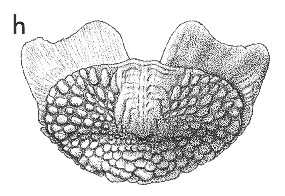
Revised descriptions of New Zealand Cenozoic Mollusca from Beu and Maxwell (1990)

 | Revised descriptions of New Zealand Cenozoic Mollusca from Beu and Maxwell (1990) | 
|
  (Pl. 44a): anterior valve from a Recent specimen, Point Chevalier, Auckland, intertidal (GNS) |
  (Pl. 44d): median valve: Te Piki, Cape Runaway, near East Cape, Haweran (oxygen isotope stage 7; National Museum of N.Z.) |
  (Pl. 44h): posterior valve: Te Piki, Cape Runaway, near East Cape, Haweran (oxygen isotope stage 7; National Museum of N.Z.) |
Beu & Maxwell (1990): Chapter 16; p. 333; pl. 44 a,d,h.
Synonymy: Acanthochites (Loboplax) mariae Webster 1908, p. 254; Loboplax stewartiana Thiele 1909, p. 37; Notoplax (Amblyplax) mariae haurakiensis Ashby 1926, p. 26; Notoplax brookesi Ashby 1929b, p. 370; Notoplax brookesi fortior Iredale and Hull 1931, p. 66; Acanthochitona (Notoplax) mariae, Beu & Maxwell 1990. p. 333, pl. 44a, d, h.
Classification: Acanthochitonidae
Description: Small (median plates to 9 mm wide, 5 mm long), moderately thin. Median valves with triangular tegmentum, almost smooth, narrowly triangular jugum, flat, oval pleural granules, a narrow radial ridge on each side, and moderately large sutural laminae with a single deep slit on each side. Anterior valve semicircular, with 5 deep slits in insertion plate, and lobate tegmentum with 5 prominent radial costae. Posterior valve with oval to subcircular tegmentum, central mucro, 2 long sutural laminae, and 5 slits around posterior.
Comparison: Notoplax mariae is smaller, narrower, more finely sculptured, and occurs to greater depths than the common intertidal living N. violacea (Quoy and Gaimard, 1835), so it is not surprising that undoubted valves of N. violacea have not been found fossil. Modern specimens of N. mariae have a relatively narrow, finely spiculous girdle, and this is one of the least specialised species referred to Notoplax. The only apparent difference between Acanthochitona and the generalised Notoplax species is the prominent radial costae on the anterior valve of species referred to Notoplax, so this species is referred to Notoplax.
Distribution: Nukumaruan-Recent; Recent, New Zealand (types of all names listed in the synonymy). Modern specimens are found on hard substrates from the intertidal zone to outer shelf depths; specimens from deeper water have a more steeply angled dorsum than those from shallow water. The second-most common of New Zealand Plio-Pleistocene fossil chitons, occurring fairly commonly at many localities of near-shore and shelf facies (the most common species is Notoplax rubiginosa, Pl. 38a-c). N. mariae is common in Nukumaruan and Castlecliffian formations of Wanganui basin, Nukumaruan blue-grey siltstone widespread in central and southern Hawke's Bay, Castlecliffian outcrops of the Ohope Beach-Ohiwa Harbour area and the Matata coast, Bay of Plenty, and the late Haweran Te Piki bed, near East Cape.
Cite this publication as: "A.G. Beu and J.I. Raine (2009). Revised
descriptions of New Zealand Cenozoic Mollusca from Beu and Maxwell (1990). GNS
Science miscellaneous series no. 27."
© GNS Science, 2009
ISBN
978-0-478-19705-1
ISSN 1177-2441
(Included with a PDF facsimile file
copy of New Zealand Geological Survey Paleontological Bulletin 58 in CD version
from: Publications Officer, GNS Science, P.O. Box 30368 Lower Hutt, New
Zealand)